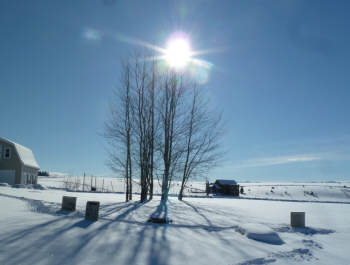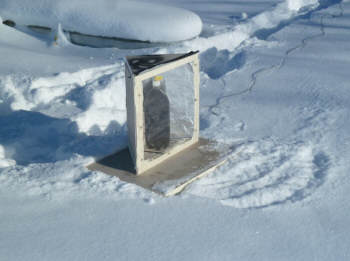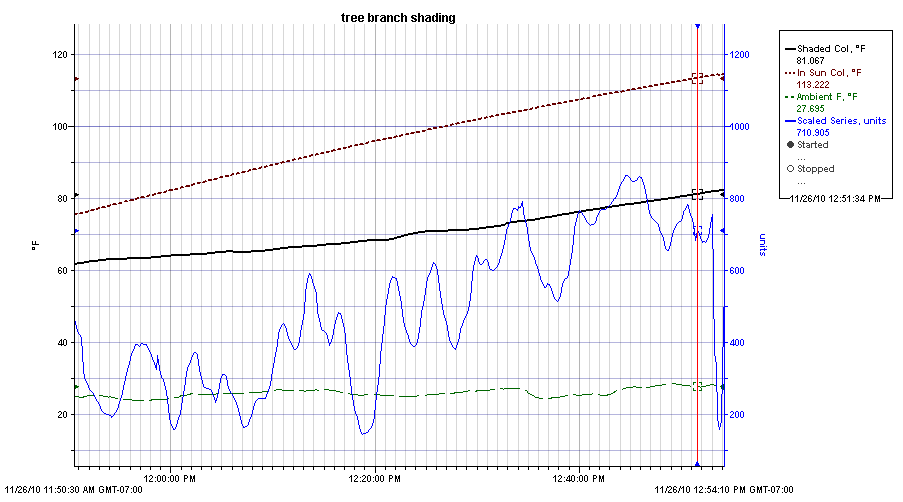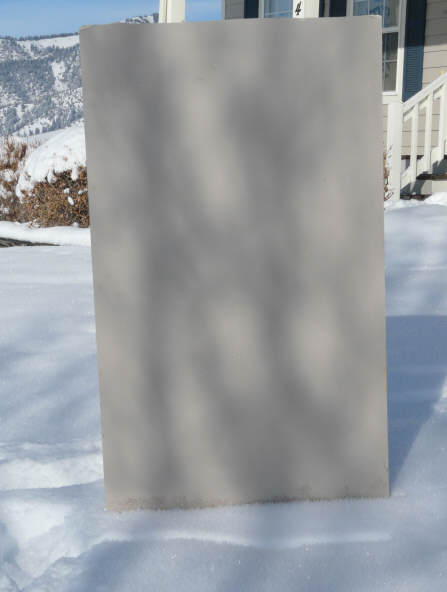
Search
The Renewable Energy site for Do-It-Yourselfers
Effect of Tree
Shade on Solar Collector Efficiency
|
This is a small test to try to determine the
actual effect of tree shading on solar collector efficiency in the winter from
deciduous trees that have lost their leafs.
Sometimes the only place you
can put collectors is in a location where they will get some shade
during the winter from trees that have lost their leafs.
Its clear when you look through he trees toward the sun, or look at the
shade pattern on the ground that some sun is getting through, but the
obvious question is how much will the collector heat output be effected?
I've not been able to find
any good method out there that will give you a good estimate of how much
of a hit you take if your collectors are shaded. There are some
rules of thumb that say the loss is about 50%, but all you have to do is
look at the variation in the kind and density of trees from site to site
to see how this kind of blanket rule cannot be very accurate. |
|
This simple method uses two small identical collectors
that consist of a glazed pane with a black painted two liter bottle of water
behind the glazing. A collector box made from rigid insulation board
finishes of the back of the collector.
Construction
The box can be easily glued together
with Great Stuff polyurethane foam in a can. To hold the foam
in place while its curing, use some weights, or you can just use nails that are
pushed in by hand. I secured the glazing with more of the Great Stuff, but
silicone caulk would work fine.
Construction Pictures:
Instrumentation
You need a way to measure the
temperature of the water in the bottle, and its best if you can record the
temperature at intervals during the day so that you can see the rate of heat up
for each bottle. I used a data logger to do this, but a couple of
the probe type thermometers that are used for making Lattes would be fine --
just drill a hole through the bottle cap and push the thermometer into the
bottle so that it measures the temperature of the liquid.
In addition to the temperature
readings on the bottles, I had a pyranometer that measures the suns intensity
through the test for the shaded collector. This is by no means necessary,
but if you want to do this, a simple one can be built
as shown in this section...
The Test
One of the collectors is placed in
full sun.
The other is placed where the tree
shadows will sweep over it.
Both collectors are aimed and tilted
the same way -- you want the only difference between the two to be the shading
from the trees.
Record the temperatures over a long
enough time period to get a good sampling of the shadows a real collector would
experience.
The temperature rise of each tells
you what the penalty is for the shadows, as the temp rise is directly
proportional to the harvested heat.
Here is a preliminary test with some
trees in my yard:

One collector in the tree shade (to left), and the other
in the open sun (to right). |

The open sun collector up close. |

This is just at the start of the
test, with the shadows just coming onto the shaded collector.
We don't have a lot of trees here, and even few deciduous trees, so this is
about the best I could do.
The unshaded collector is off to the
right just outside the tree shaded area.
Results

The first part of the test is missing
from the plot because one of the thermistors had failed -- so this picks it up a
bit into the test.
So, there are logged temps for the
water temperature in the 2 liter bottles in each collector.
A log of the ambient temperature.
A log of the incident solar energy (pyranometer)
for the shaded collector.
If you take the about 1 hour from
11:50 am to 12:50 pm, the gain in temperature for the unshaded collector is
nearly twice the shaded one.
The pyranometer readings are kind of
interesting. They go up and down as you would expect, but they never get
up to full sun. I should have taken a reading in full sun, but I'm
thinking that given the very clear sky and snow reflection that it was over 1000
watt/sm.
So, maybe, even when the collector is
not in a direct branch shadow, there is still a dimming effect from the tree as
a whole? It sort of looks this way when you look at the shadow pattern on
the snow.

This shows the tree shade on a board. Interesting that the shadow
edges are fuzzy -- hot sharp edged.
I'll probably repeat this test when I
can get a good clean full sun period.
Science Fair Project
I think that these little collectors
are the basis for a great Science Fair or school project.
One idea would be to do the same type
of test as is shown above for several kinds of tree shading. Then put
together a report that shows pictures of the shading along with the reduction in
collector heat output. People who are thinking about placing their
collectors in a shaded or part shaded spot could pick the picture of shading
from the report that best matches their shading and get a good idea what their
shading would cost them. This would be a genuinely useful tool, and to the
best of knowledge one that no one has done. I'd be happy to publish the
results on Build-It-Solar.
There are a lot of other good
projects that could be done using these simple small collectors. How do
different glazing materials compare? Is it better to have the inside of
the box painted black or to use aluminum foil?...
Extending this a bit further, what if
you use solar electric collectors instead of solar thermal collectors?
Isn't Physics fun!!
John Canivan has done some tests with
small collectors using a bottle -- have a look at them on
John's website...
Gary March 25, 2011

